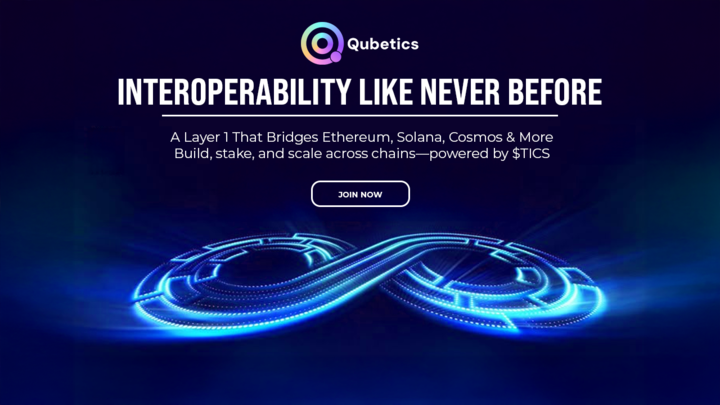
From Smart Devs to Big DeFi—Why Qubetics, ICP, and Arbitrum Are the Top Cryptos to Join for 2025
The crypto world doesn’t slow down. Just last week, the total value locked (TVL) in Ethereum L2 solutions crossed $45 billion, showing clear signs that decentralized apps, cross-chain solutions, and digital ownership aren’t some niche tech chatter anymore—they’re how people are managing assets, contracts, and work across borders. From Latin America to Southeast Asia, blockchain is no longer a tech hobby—it’s a survival, especially in countries where inflation bites harder than ever and traditional banks gatekeep even basic services. In this shift, people are ditching slow legacy systems and joining platforms offering control, speed, and real returns.
That’s where platforms like Qubetics, Arbitrum, and Internet Computer Protocol (ICP) come into focus. These aren’t fly-by-night tokens flashing hype with no follow-through. They’ve got strong traction, surging token holders, and use cases that people can understand. Whether it’s interoperability that ends app fragmentation, rollup tech that brings fees to cents, or cloud reimagined for decentralization—these three names are being recognized as top cryptos to join for 2025. If you’re tired of watching from the sidelines while others back projects early and reap the upside, now’s the time to look into what these ecosystems are building.
Qubetics ($TICS): The World’s First Web3 Aggregator Is Breaking Silos
Right now, Qubetics is sitting at Stage 30 of its crypto presale with a live price of $0.1729. Over $16.2 million has already been raised, with 508 million tokens sold and 24,900+ token holders already locked in. It’s not just gaining traction—it’s becoming the preferred option for people who missed out on early-stage Ethereum, Cardano, or Filecoin. But this isn’t nostalgia. Qubetics is doing something they didn’t: building for interoperability from day one.
With Qubetics, wallets, dApps, protocols, and chains stop acting like rival nations and start syncing like a unified system. Think of a Colombian freelance designer using a wallet from Solana, invoicing a Canadian client via Ethereum-based stablecoin, while tracking taxes on a BNB-backed dApp—all without swapping interfaces, juggling extensions, or losing funds to bridges. That’s what Qubetics’ interoperability delivers. It’s like having a universal remote in a chaotic tech world where nothing usually talks to each other.
With $TICS forecasted by some analysts to hit between $5 to $15 in the coming years, the return outlook is ridiculous. A $500 entry today could be the kind of decision that folks look back on, wondering why they hesitated. It solves a broken multi-chain experience that everyone silently suffers from, one of the top cryptos to join for 2025.
$1,000 Investment in Qubetics ($TICS)
Back when Qubetics ($TICS) launched its presale, early backers were scooping up tokens at mere fractions of a dollar. Now, with the price reaching $0.1729, the momentum is undeniable—and those who act now are still catching it before liftoff. A $1,000 investment at today’s rate grabs approximately 5,787 $TICS tokens—a powerful stake in what many are calling the next titan of interoperability and Web3 aggregation.
If $TICS hits just $1, that $1,000 turns into $5,787. At $5, it grows to $28,935. And if the token hits $10, you’re sitting on $57,870. But here’s the kicker—if Qubetics reaches $15, your $1,000 turns into a staggering $86,805. That’s not some moonshot fantasy—it’s the kind of return that rewrites financial futures. With the presale clock ticking and whales already circling, the window to enter below 20 cents won’t stay open much longer.
Arbitrum (ARB): Ethereum’s Efficiency Wingman with Real Scaling Power
When gas fees went wild back in 2021, a lot of folks started hunting for Ethereum alternatives. Arbitrum didn’t try to replace ETH—it supercharged it. As a rollup chain, it bundles transactions off-chain and settles them efficiently on Ethereum. The result? Super low fees and faster transactions without compromising the ETH ecosystem. That’s a win-win, and why Arbitrum’s TVL sits comfortably above $15 billion today. Over 1.7 million wallets now interact with Arbitrum monthly. It’s the home of some of the most popular dApps in 2025, including GMX and Radiant.
Developer-first upgrades and community grants that get deployed, not shelved. With Layer 3 discussions heating up and Arbitrum Orbit pushing toward app-specific chains, the protocol is quietly gearing up for its next leap, and with its continuous dominance in Ethereum scaling and the expansion of Arbitrum Stylus (a WASM-compatible dev environment), adoption is only widening. The backers here aren’t casual users—they’re builders, fund allocators, and communities betting long-term, one of the top cryptos to join for 2025.
Internet Computer Protocol (ICP): The Decentralized Cloud That Won’t Quit
Internet Computer was once labeled too ambitious. Build a decentralized internet? Host apps that run entirely on-chain? But five years later, ICP is still standing, and in 2025, it’s starting to flip perceptions. With direct integration into Bitcoin and Ethereum networks, ICP isn’t chasing the spotlight—it’s building its infrastructure in the background. Its canister smart contracts (unique in design and scale) are powering entire decentralized services—from social media alternatives to supply chain dashboards that never touch a centralized server.
It’s also the only protocol offering web-speed finality with data storage included. That combo puts it in a rare class. Community-driven updates like chain-key Bitcoin integration and support for Ethereum tokens have pushed ICP back into the conversation as one of the top cryptos to join for 2025. There’s room to grow, and its narrative as “the chain that runs the entire stack” makes it more than just a moonshot—it’s now proving its technical edge block by block. It’s quietly redefining what on-chain means—without the noise.
Conclusion: Waiting Doesn’t Work Anymore—Participation Does
Back in 2017, watching Bitcoin shoot from $1,000 to $20,000 felt surreal. In 2021, NFTs and DeFi exploded while many sat on the sidelines. Now in 2025, the same story is unfolding with platforms like Qubetics, Arbitrum, and ICP—except this time, it’s not hype driving decisions, it’s utility. These aren’t gamble plays. These are structured, growing ecosystems solving real-world problems across banking alternatives, developer tools, and multi-chain apps.
If you’re looking for top cryptos to join for 2025, this trio isn’t just rising—they’re reshaping how digital systems are built and used. Whether you’re a tech-savvy dev, a small business owner, or someone just tired of outdated systems, the door is wide open—but it won’t stay open forever. Join the momentum. Explore $TICS while the presale is still open, and take a closer look at Arbitrum and ICP while the price window is still reasonable.
For More Information:
Qubetics: https://qubetics.com
Presale: https://buy.qubetics.com/
Telegram: https://t.me/qubetics
Twitter: https://x.com/qubetics
FAQs
1. What makes Qubetics different from other altcoins in 2025?
Qubetics is the first platform that fully aggregates Web3 protocols, wallets, and dApps into a single, interoperable layer. It makes multi-chain use seamless for businesses and individuals.
2. Is Arbitrum better than Ethereum for new projects?
Arbitrum isn’t competing with Ethereum—it scales it. It reduces gas fees and boosts speed, making it a prime choice for developers who want Ethereum security with better UX.
3. How is ICP being used in real life right now?
ICP powers decentralized apps that store data, process transactions, and run backend logic—all on-chain. It’s being used in sectors like healthcare, social media, and logistics.
| Disclaimer: The text above is an advertorial article that is not part of kanalcoin.com editorial content. |









